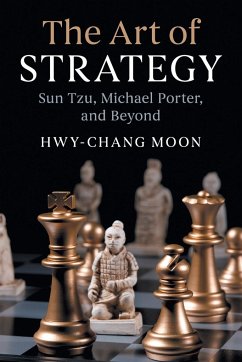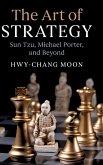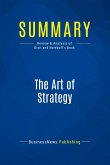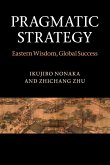Hwy-Chang Moon
The Art of Strategy
Hwy-Chang Moon
The Art of Strategy
- Broschiertes Buch
- Merkliste
- Auf die Merkliste
- Bewerten Bewerten
- Teilen
- Produkt teilen
- Produkterinnerung
- Produkterinnerung
A novel integration and extension of two global strategy classics: Sun Tzu's military strategy and Michael Porter's business strategy.
Andere Kunden interessierten sich auch für
![The Art of Strategy The Art of Strategy]() Hwy-Chang MoonThe Art of Strategy83,99 €
Hwy-Chang MoonThe Art of Strategy83,99 €![The Art of Strategy The Art of Strategy]() Owen E. HughesThe Art of Strategy185,99 €
Owen E. HughesThe Art of Strategy185,99 €![Summary: The Art of Strategy Summary: The Art of Strategy]() Businessnews PublishingSummary: The Art of Strategy9,99 €
Businessnews PublishingSummary: The Art of Strategy9,99 €![The Art of Strategy The Art of Strategy]() Owen E. HughesThe Art of Strategy50,99 €
Owen E. HughesThe Art of Strategy50,99 €![Crafting Strategy Crafting Strategy]() Loizos HeracleousCrafting Strategy95,99 €
Loizos HeracleousCrafting Strategy95,99 €![Cambridge Handbook of Open Strategy Cambridge Handbook of Open Strategy]() Cambridge Handbook of Open Strategy146,99 €
Cambridge Handbook of Open Strategy146,99 €![Pragmatic Strategy Pragmatic Strategy]() Ikujiro NonakaPragmatic Strategy52,99 €
Ikujiro NonakaPragmatic Strategy52,99 €-
-
-
A novel integration and extension of two global strategy classics: Sun Tzu's military strategy and Michael Porter's business strategy.
Hinweis: Dieser Artikel kann nur an eine deutsche Lieferadresse ausgeliefert werden.
Hinweis: Dieser Artikel kann nur an eine deutsche Lieferadresse ausgeliefert werden.
Produktdetails
- Produktdetails
- Verlag: Cambridge University Press
- Seitenzahl: 334
- Erscheinungstermin: 31. Juli 2018
- Englisch
- Abmessung: 229mm x 152mm x 19mm
- Gewicht: 485g
- ISBN-13: 9781108455800
- ISBN-10: 1108455808
- Artikelnr.: 52423415
- Herstellerkennzeichnung
- Libri GmbH
- Europaallee 1
- 36244 Bad Hersfeld
- gpsr@libri.de
- Verlag: Cambridge University Press
- Seitenzahl: 334
- Erscheinungstermin: 31. Juli 2018
- Englisch
- Abmessung: 229mm x 152mm x 19mm
- Gewicht: 485g
- ISBN-13: 9781108455800
- ISBN-10: 1108455808
- Artikelnr.: 52423415
- Herstellerkennzeichnung
- Libri GmbH
- Europaallee 1
- 36244 Bad Hersfeld
- gpsr@libri.de
Hwy-Chang Moon is Professor at the Graduate School of International Studies, Seoul National University. Dr Moon has consulted many Korean and multinational companies, international organizations (e.g. UNCTAD) and governments (e.g. Korea, Malaysia, Dubai, Azerbaijan, Guangdong Province of China, and India). He has published numerous articles and books on topics covering International Business Strategy and Economic Development, including The Strategy for Korea's Economic Success (2016).
Introduction
1. Getting started: overall assessment
1.1. Sun Tzu: five elements for laying plans
1.2. Porter: diamond model for analyzing competitiveness
1.3. The integration of Sun Tzu and Porter
1.4. Military case: Japanese attack on Pearl Harbor
1.5. Business case: Sony's experience with the Walkman
1.6. Conclusion and implications
2. Economic consideration
2.1. Sun Tzu: swift victory and local procurement in waging war
2.2 Porter: value chain analysis in aligning activities
2.3. The integration of Sun Tzu and Porter
2.4. Military case: Napoleon's invasion of Russia
2.5. Business case: Hyundai Motor's global strategy
2.6. Conclusion and implications
3. Avoiding competition
3.1. Sun Tzu: complete victory by strategic attack
3.2. Porter: five forces model for selecting the most attractive industry
3.3. The integration of Sun Tzu and Porter
3.4. Military case: Genghis Khan's terror strategy
3.5. Business case: the changing attractiveness of the mobile phone industry
3.6. Conclusion and implications
4. Competitive positioning
4.1. Sun Tzu: easy victory through tactical positioning
4.2. Porter: generic strategy for advantageous positioning
4.3. The integration of Sun Tzu and Porter
4.4. Military case: Soviet's victory in the Battle of Stalingrad
4.5. Business case: Toyota's changing position in automobile industry
4.6. Conclusion and implications
5. Enhanced advantage
5.1. Sun Tzu: synergies from the combination of Cheng (Normal) and Chi (Abnormal)
5.2. Distinguishing operational effectiveness (OE) and strategic positioning (SP)
5.3. The integration of Sun Tzu and Porter
5.4. Military case: the US failure in the Vietnam War
5.5. Business case: Walmart's cost leadership strategy
5.6. Conclusion and implications
6. Unique positioning
6.1. Sun Tzu: avoiding enemy's strengths and attacking their weaknesses
6.2. Porter: choosing trade-offs for strategic fit
6.3. The integration of Sun Tzu and Porter
6.4. Military case: Hannibal's victory at Cannae
6.5. Business case: Southwest Airlines' unique positioning
6.6. Conclusion and implication
7. Overcoming disadvantages
7.1. Sun Tzu: turning the devious (disadvantage) into the direct (advantage)
7.2. Porter: turning corporate social responsibility (CSR) to creating shared value (CSV)
7.3. The integration of Sun Tzu and Porter
7.4. Military case: the long march of the Red Army
7.5. Business case: Nestlé's CSV activities in India
7.6. Conclusion and implications
8. Strategic flexibility
8.1. Sun Tzu: variation of tactics
8.2. Porter: consistency and changes in business strategy
8.3. The integration of Sun Tzu and Porter
8.4. Military case: the victory of the Greeks in the Trojan War
8.5. Business case: Haier's successful transition through changes in its business strategy
8.6. Conclusion and implications
9. Extended strategies
9.1 Sun Tzu: troop deployment and enemy investigation
9.2. Porter: extended generic strategies
9.3. The Integration of Sun Tzu and Porter
9.4. Military case: Han Xin's victory in the Battle of Jingxing
9.5. Business case: Tata Motor's failure in Tata Nano
9.6. Conclusion and implications
10. Location advantage
10.1. Sun Tzu: exploitation of the terrain advantages
10.2. Porter: cluster development for improving location advantage
10.3. The integration of Sun Tzu and Porter
10.4. Military case: Admiral Yi's victory in the Battle of Myeongnyang
10.5. Business case: the competitiveness of Silicon Valley
10.6. Conclusion and implications
11. International strategy
11.1. Sun Tzu: expeditionary strategy in the enemy territory
11.2. Porter: configuration-coordination model for firms' internationalization
11.3. The integration of Sun Tzu and Porter
11.4. Military case: the UN Forces' victory in the Battle of Incheon
11.5. Business case: Starbucks' success in China
11.6. Conclusion and implicati
1. Getting started: overall assessment
1.1. Sun Tzu: five elements for laying plans
1.2. Porter: diamond model for analyzing competitiveness
1.3. The integration of Sun Tzu and Porter
1.4. Military case: Japanese attack on Pearl Harbor
1.5. Business case: Sony's experience with the Walkman
1.6. Conclusion and implications
2. Economic consideration
2.1. Sun Tzu: swift victory and local procurement in waging war
2.2 Porter: value chain analysis in aligning activities
2.3. The integration of Sun Tzu and Porter
2.4. Military case: Napoleon's invasion of Russia
2.5. Business case: Hyundai Motor's global strategy
2.6. Conclusion and implications
3. Avoiding competition
3.1. Sun Tzu: complete victory by strategic attack
3.2. Porter: five forces model for selecting the most attractive industry
3.3. The integration of Sun Tzu and Porter
3.4. Military case: Genghis Khan's terror strategy
3.5. Business case: the changing attractiveness of the mobile phone industry
3.6. Conclusion and implications
4. Competitive positioning
4.1. Sun Tzu: easy victory through tactical positioning
4.2. Porter: generic strategy for advantageous positioning
4.3. The integration of Sun Tzu and Porter
4.4. Military case: Soviet's victory in the Battle of Stalingrad
4.5. Business case: Toyota's changing position in automobile industry
4.6. Conclusion and implications
5. Enhanced advantage
5.1. Sun Tzu: synergies from the combination of Cheng (Normal) and Chi (Abnormal)
5.2. Distinguishing operational effectiveness (OE) and strategic positioning (SP)
5.3. The integration of Sun Tzu and Porter
5.4. Military case: the US failure in the Vietnam War
5.5. Business case: Walmart's cost leadership strategy
5.6. Conclusion and implications
6. Unique positioning
6.1. Sun Tzu: avoiding enemy's strengths and attacking their weaknesses
6.2. Porter: choosing trade-offs for strategic fit
6.3. The integration of Sun Tzu and Porter
6.4. Military case: Hannibal's victory at Cannae
6.5. Business case: Southwest Airlines' unique positioning
6.6. Conclusion and implication
7. Overcoming disadvantages
7.1. Sun Tzu: turning the devious (disadvantage) into the direct (advantage)
7.2. Porter: turning corporate social responsibility (CSR) to creating shared value (CSV)
7.3. The integration of Sun Tzu and Porter
7.4. Military case: the long march of the Red Army
7.5. Business case: Nestlé's CSV activities in India
7.6. Conclusion and implications
8. Strategic flexibility
8.1. Sun Tzu: variation of tactics
8.2. Porter: consistency and changes in business strategy
8.3. The integration of Sun Tzu and Porter
8.4. Military case: the victory of the Greeks in the Trojan War
8.5. Business case: Haier's successful transition through changes in its business strategy
8.6. Conclusion and implications
9. Extended strategies
9.1 Sun Tzu: troop deployment and enemy investigation
9.2. Porter: extended generic strategies
9.3. The Integration of Sun Tzu and Porter
9.4. Military case: Han Xin's victory in the Battle of Jingxing
9.5. Business case: Tata Motor's failure in Tata Nano
9.6. Conclusion and implications
10. Location advantage
10.1. Sun Tzu: exploitation of the terrain advantages
10.2. Porter: cluster development for improving location advantage
10.3. The integration of Sun Tzu and Porter
10.4. Military case: Admiral Yi's victory in the Battle of Myeongnyang
10.5. Business case: the competitiveness of Silicon Valley
10.6. Conclusion and implications
11. International strategy
11.1. Sun Tzu: expeditionary strategy in the enemy territory
11.2. Porter: configuration-coordination model for firms' internationalization
11.3. The integration of Sun Tzu and Porter
11.4. Military case: the UN Forces' victory in the Battle of Incheon
11.5. Business case: Starbucks' success in China
11.6. Conclusion and implicati
Introduction
1. Getting started: overall assessment
1.1. Sun Tzu: five elements for laying plans
1.2. Porter: diamond model for analyzing competitiveness
1.3. The integration of Sun Tzu and Porter
1.4. Military case: Japanese attack on Pearl Harbor
1.5. Business case: Sony's experience with the Walkman
1.6. Conclusion and implications
2. Economic consideration
2.1. Sun Tzu: swift victory and local procurement in waging war
2.2 Porter: value chain analysis in aligning activities
2.3. The integration of Sun Tzu and Porter
2.4. Military case: Napoleon's invasion of Russia
2.5. Business case: Hyundai Motor's global strategy
2.6. Conclusion and implications
3. Avoiding competition
3.1. Sun Tzu: complete victory by strategic attack
3.2. Porter: five forces model for selecting the most attractive industry
3.3. The integration of Sun Tzu and Porter
3.4. Military case: Genghis Khan's terror strategy
3.5. Business case: the changing attractiveness of the mobile phone industry
3.6. Conclusion and implications
4. Competitive positioning
4.1. Sun Tzu: easy victory through tactical positioning
4.2. Porter: generic strategy for advantageous positioning
4.3. The integration of Sun Tzu and Porter
4.4. Military case: Soviet's victory in the Battle of Stalingrad
4.5. Business case: Toyota's changing position in automobile industry
4.6. Conclusion and implications
5. Enhanced advantage
5.1. Sun Tzu: synergies from the combination of Cheng (Normal) and Chi (Abnormal)
5.2. Distinguishing operational effectiveness (OE) and strategic positioning (SP)
5.3. The integration of Sun Tzu and Porter
5.4. Military case: the US failure in the Vietnam War
5.5. Business case: Walmart's cost leadership strategy
5.6. Conclusion and implications
6. Unique positioning
6.1. Sun Tzu: avoiding enemy's strengths and attacking their weaknesses
6.2. Porter: choosing trade-offs for strategic fit
6.3. The integration of Sun Tzu and Porter
6.4. Military case: Hannibal's victory at Cannae
6.5. Business case: Southwest Airlines' unique positioning
6.6. Conclusion and implication
7. Overcoming disadvantages
7.1. Sun Tzu: turning the devious (disadvantage) into the direct (advantage)
7.2. Porter: turning corporate social responsibility (CSR) to creating shared value (CSV)
7.3. The integration of Sun Tzu and Porter
7.4. Military case: the long march of the Red Army
7.5. Business case: Nestlé's CSV activities in India
7.6. Conclusion and implications
8. Strategic flexibility
8.1. Sun Tzu: variation of tactics
8.2. Porter: consistency and changes in business strategy
8.3. The integration of Sun Tzu and Porter
8.4. Military case: the victory of the Greeks in the Trojan War
8.5. Business case: Haier's successful transition through changes in its business strategy
8.6. Conclusion and implications
9. Extended strategies
9.1 Sun Tzu: troop deployment and enemy investigation
9.2. Porter: extended generic strategies
9.3. The Integration of Sun Tzu and Porter
9.4. Military case: Han Xin's victory in the Battle of Jingxing
9.5. Business case: Tata Motor's failure in Tata Nano
9.6. Conclusion and implications
10. Location advantage
10.1. Sun Tzu: exploitation of the terrain advantages
10.2. Porter: cluster development for improving location advantage
10.3. The integration of Sun Tzu and Porter
10.4. Military case: Admiral Yi's victory in the Battle of Myeongnyang
10.5. Business case: the competitiveness of Silicon Valley
10.6. Conclusion and implications
11. International strategy
11.1. Sun Tzu: expeditionary strategy in the enemy territory
11.2. Porter: configuration-coordination model for firms' internationalization
11.3. The integration of Sun Tzu and Porter
11.4. Military case: the UN Forces' victory in the Battle of Incheon
11.5. Business case: Starbucks' success in China
11.6. Conclusion and implicati
1. Getting started: overall assessment
1.1. Sun Tzu: five elements for laying plans
1.2. Porter: diamond model for analyzing competitiveness
1.3. The integration of Sun Tzu and Porter
1.4. Military case: Japanese attack on Pearl Harbor
1.5. Business case: Sony's experience with the Walkman
1.6. Conclusion and implications
2. Economic consideration
2.1. Sun Tzu: swift victory and local procurement in waging war
2.2 Porter: value chain analysis in aligning activities
2.3. The integration of Sun Tzu and Porter
2.4. Military case: Napoleon's invasion of Russia
2.5. Business case: Hyundai Motor's global strategy
2.6. Conclusion and implications
3. Avoiding competition
3.1. Sun Tzu: complete victory by strategic attack
3.2. Porter: five forces model for selecting the most attractive industry
3.3. The integration of Sun Tzu and Porter
3.4. Military case: Genghis Khan's terror strategy
3.5. Business case: the changing attractiveness of the mobile phone industry
3.6. Conclusion and implications
4. Competitive positioning
4.1. Sun Tzu: easy victory through tactical positioning
4.2. Porter: generic strategy for advantageous positioning
4.3. The integration of Sun Tzu and Porter
4.4. Military case: Soviet's victory in the Battle of Stalingrad
4.5. Business case: Toyota's changing position in automobile industry
4.6. Conclusion and implications
5. Enhanced advantage
5.1. Sun Tzu: synergies from the combination of Cheng (Normal) and Chi (Abnormal)
5.2. Distinguishing operational effectiveness (OE) and strategic positioning (SP)
5.3. The integration of Sun Tzu and Porter
5.4. Military case: the US failure in the Vietnam War
5.5. Business case: Walmart's cost leadership strategy
5.6. Conclusion and implications
6. Unique positioning
6.1. Sun Tzu: avoiding enemy's strengths and attacking their weaknesses
6.2. Porter: choosing trade-offs for strategic fit
6.3. The integration of Sun Tzu and Porter
6.4. Military case: Hannibal's victory at Cannae
6.5. Business case: Southwest Airlines' unique positioning
6.6. Conclusion and implication
7. Overcoming disadvantages
7.1. Sun Tzu: turning the devious (disadvantage) into the direct (advantage)
7.2. Porter: turning corporate social responsibility (CSR) to creating shared value (CSV)
7.3. The integration of Sun Tzu and Porter
7.4. Military case: the long march of the Red Army
7.5. Business case: Nestlé's CSV activities in India
7.6. Conclusion and implications
8. Strategic flexibility
8.1. Sun Tzu: variation of tactics
8.2. Porter: consistency and changes in business strategy
8.3. The integration of Sun Tzu and Porter
8.4. Military case: the victory of the Greeks in the Trojan War
8.5. Business case: Haier's successful transition through changes in its business strategy
8.6. Conclusion and implications
9. Extended strategies
9.1 Sun Tzu: troop deployment and enemy investigation
9.2. Porter: extended generic strategies
9.3. The Integration of Sun Tzu and Porter
9.4. Military case: Han Xin's victory in the Battle of Jingxing
9.5. Business case: Tata Motor's failure in Tata Nano
9.6. Conclusion and implications
10. Location advantage
10.1. Sun Tzu: exploitation of the terrain advantages
10.2. Porter: cluster development for improving location advantage
10.3. The integration of Sun Tzu and Porter
10.4. Military case: Admiral Yi's victory in the Battle of Myeongnyang
10.5. Business case: the competitiveness of Silicon Valley
10.6. Conclusion and implications
11. International strategy
11.1. Sun Tzu: expeditionary strategy in the enemy territory
11.2. Porter: configuration-coordination model for firms' internationalization
11.3. The integration of Sun Tzu and Porter
11.4. Military case: the UN Forces' victory in the Battle of Incheon
11.5. Business case: Starbucks' success in China
11.6. Conclusion and implicati








